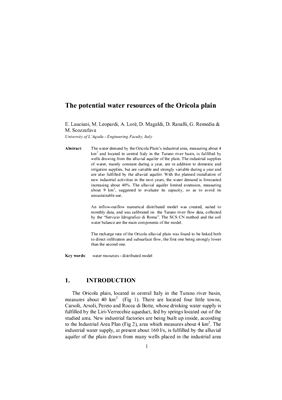Lauciani E. , Leopardi M. , Lor? A. , Magaldi D. , Ranalli D. ,
Remedia G. The potential water resources of the Oricola plain,
2005, University of L’Aquila - Engineering Faculty, Italy.
(На англ. / Потенциальные водные ресурсы долины Орикола).
Abstract.
The water demand by the Oricola Plain’s industrial area, measuring about 4
km2 and located in central Italy in the Turano river basin, is fulfilled by
wells drawing from the alluvial aquifer of the plain. The industrial supplies
of water, mainly constant during a year, are in addition to domestic and
irrigation supplies, but are variable and strongly variable during a year and
are also fulfilled by the alluvial aquifer. With the planned installation of
new industrial activities in the next years, the water demand is forecasted
increasing about 40%. The alluvial aquifer limited extension, measuring
about 9 km2, suggested to evaluate its capacity, so as to avoid its
unsustainable use.
An inflow-outflow numerical distributed model was created, suited to
monthly data, and was calibrated on the Turano river flow data, collected
by the Servizio Idrografico di Roma. The SCS CN method and the soil
water balance are the main components of the model.
The recharge rate of the Oricola alluvial plain was found to be linked both
to direct infiltration and subsurface flow, the first one being strongly lower
than the second one.
(На англ. / Потенциальные водные ресурсы долины Орикола).
Abstract.
The water demand by the Oricola Plain’s industrial area, measuring about 4
km2 and located in central Italy in the Turano river basin, is fulfilled by
wells drawing from the alluvial aquifer of the plain. The industrial supplies
of water, mainly constant during a year, are in addition to domestic and
irrigation supplies, but are variable and strongly variable during a year and
are also fulfilled by the alluvial aquifer. With the planned installation of
new industrial activities in the next years, the water demand is forecasted
increasing about 40%. The alluvial aquifer limited extension, measuring
about 9 km2, suggested to evaluate its capacity, so as to avoid its
unsustainable use.
An inflow-outflow numerical distributed model was created, suited to
monthly data, and was calibrated on the Turano river flow data, collected
by the Servizio Idrografico di Roma. The SCS CN method and the soil
water balance are the main components of the model.
The recharge rate of the Oricola alluvial plain was found to be linked both
to direct infiltration and subsurface flow, the first one being strongly lower
than the second one.

